16 January 2025
JavaScript frameworks in frontend development: What to expect in 2025?
Performance and user experience have become top priorities for frontend developers, who look for lightweight solutions for often feature-heavy apps. This demand has led to the rise of several new web frameworks that are currently gaining traction, including Qwik and Astro (yes, we know it’s not exclusively a JavaScript framework but a static site generator considered framework-agnostic, but since it supports JavaScript frameworks like React, Vue, and Svelte we decided to include Astro as well).
In the latest State of Frontend report, we surveyed over 6,000 developers worldwide. Frameworks were one of the main focuses of our study, and we asked about the tools they currently use and which ones they’d like to learn in the future. Here is a recap of our findings.
Web development frameworks – top picks among developers
When it comes to the top spot, there are no surprises – React continues to be the most popular choice for web development. 69.9% of respondents to our 2024 State of Frontend Report said that they use and enjoy working with the framework.
Out of rendering frameworks (you’ve guessed it), Next.js is the most popular, securing a 52.9% usage and positive sentiment score. And so, the React/Next.js setup remains the most popular combination yet again.
That said, now that they face competition from new web frameworks, it’ll be interesting to see how React’s and Next.js’s roles evolve over the next couple of years.
Of the newest frameworks, Svelte seems to be the biggest threat to the status quo. It’s already used by 25.8% of frontend developers, and another 43.6% declare that they’d like to learn it in the future.
Dane Nk, Owner and Webmaster of thatvideogameblog.com, says,”Svelte’s focus on simplicity and performance could force developers to rethink bloated architectures. The controversy? Framework wars aren’t about tools; they’re about mindset. Svelte doesn’t just add to the ecosystem — it calls out inefficiency. That’s why it’s not just a trend; it’s the future.”
Vue.js and Angular also remain among the most used frameworks. Vue.js is used (and liked) by 44.8% of respondents. And judging by developers’ interest, it seems like it’s not going anywhere anytime soon – 24.4% of developers who don’t currently use it say they’d like to learn it.
This can’t be said about Angular, as the future of this web app framework seems murky. 22.1% of frontend developers use Angular 2+ and 6.7% use Angular.js. What’s especially concerning is the number of “used and dislike it” responses (12.8% and 19.3%, respectively). Also, 49% of respondents said they weren’t interested in learning it. This declining popularity likely comes from factors like Angular’s steep learning curve and less flexibility compared to other established frameworks like React and Vue.js.
It’s worth mentioning that the popularity of various frontend frameworks may shift due to updates from 2024 and new features expected to roll out in 2025. Here are some of the most important features:
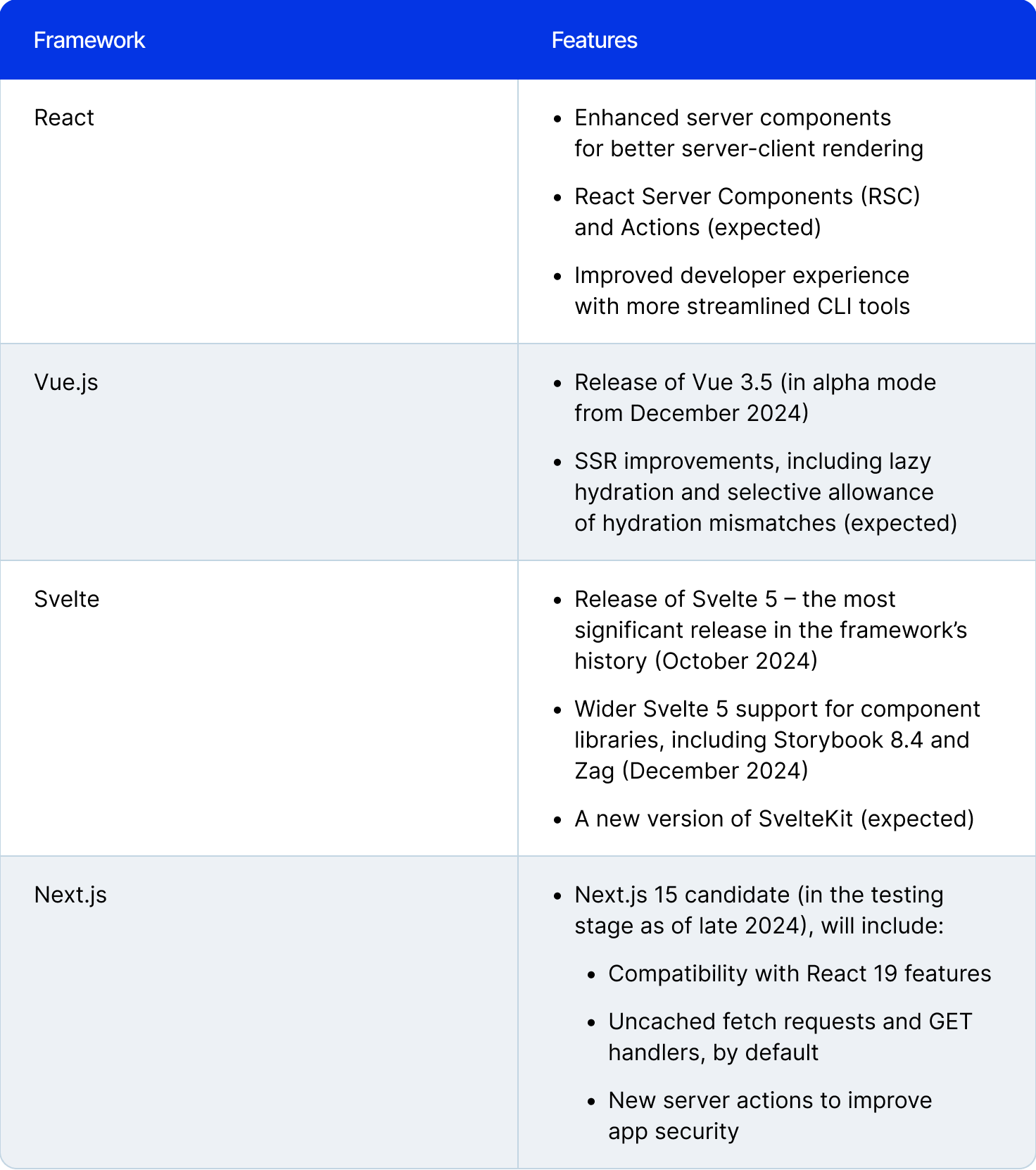
Planning frontend changes or improvements?
React dominates. What will happen in the foreseeable future?

The 2024 State of Frontend report is the first edition in which we’ve noticed a decline (6.3%) in React popularity—from 76.2% in 2022 to the already-mentioned 69.9% of “used and like” responses.
Does this come down to ‘newer’ web development frameworks luring developers’ attention away? Possibly, especially if we look at Svelte’s popularity. Still, these slight changes in usage and developer interests can’t threaten React’s dominance in 2025.
React has a strong position among C-suite executives and tech leaders. 25.9% of the IT leaders we surveyed told us they were planning to modernize their applications with React and its related ecosystems.
Steve Pogson from First Pier, a Shopify development agency, told us: “React’s vast ecosystem and backing from a global community make it resilient against emerging competitors like Solid or Astro”. He said that if you look at the importance of React in Shopify integrations and its app ecosystem, it’s easy to notice React’s indispensable role in modern e-commerce platforms. “New frameworks may offer fresh paradigms, but React’s mature tooling and extensive adoption in complex projects ensure it remains a cornerstone for developers beyond 2025”, he added.
Another argument in favor of React’s importance in the future of web development is the release of React 19. Announced in mid-2024, the new version is set to bring major updates, focusing on the developer experience, versatility, and app performance. Ethan Moss, founder of AI Humanize, told us that “the potential new features of React 19 could significantly improve the developer experience, with server components offering new ways to optimize app performance, and concurrent mode unlocking smoother UI animations. These updates could reinforce React’s dominance through 2025 and beyond”.
Moss added that React’s leadership is unquestionable. Newer frameworks, like Svelte or Vue, are gaining traction with their simplicity and versatility. By 2025, they may compete head-to-head with React, particularly if they continue their aggressive evolution pace.
Some of the key changes over the React 18 version include:
- React Server Components (RSC). These are expected to enhance server-side data management, offload tasks from the client, and improve page loading times.
- Actions API. Merging client and server logic to simplify form handling and eliminate unnecessary code.
- UI improvements. Improvements in user interaction responsiveness, including smoother interfaces while developers await server responses.
- Concurrent rendering enhancements. Facilitates complex, asynchronous updates without disrupting the main thread, improving app interactivity.
Emerging competitors
Astro – The web framework for content-driven websites

Astro was among the most used rendering frameworks in 2024, right after Next.js. Our 2024 SOFE report revealed that over 25% of developers used Astro and liked it, while nearly 30% said they would like to learn it in the future.
Why is Astro such a favorite for developers?
It might be its templating language, which is easy to learn for those who know HTML and JSX. With Astro’s templating language, developers can build reusable components or layouts. Astro components don’t need any client-side runtime when compared to React ones. How so? They’re converted into HTML during the build process and loaded onto the site automatically, which guarantees great performance. React components, on the other hand, rely on JavaScript frameworks and the virtual DOM.
Astro is truly library- and framework-agnostic, so whichever tool you prefer – be it React, Vue, or Svelte – will work with Astro. And the best part is that you can combine multiple libraries or frameworks in the same project. For example, you can use React for some components, Vue for others, and Svelte for another part, all in one codebase. This mix-and-match ability makes Astro a great candidate for building micro-frontends.
Astro focuses on delivering optimized experiences for users in the browser. Thanks to its partial hydration features, it minimizes unnecessary JavaScript and resources to offer fast performance. Partial hydration allows only the essential parts of a webpage (specific components) to load JavaScript for interactivity. The rest of the page remains static HTML. This reduces the amount of JavaScript sent to the browser, speeding up loading times and improving user experience.
How does Astro compare to Next.js and React?
First of all, these are two very different frameworks. Next.js is a full-stack framework built with React in mind, while Astro is a static site generator that supports React. While the former offers both client and server-side functionality, the latter focuses on the client side only. For this reason, it’s hard, if not impossible, to compare the features of these two platforms objectively, as their core functionalities are different, and so are their priorities.
Here is a short overview of Astro, React, and Next.js.
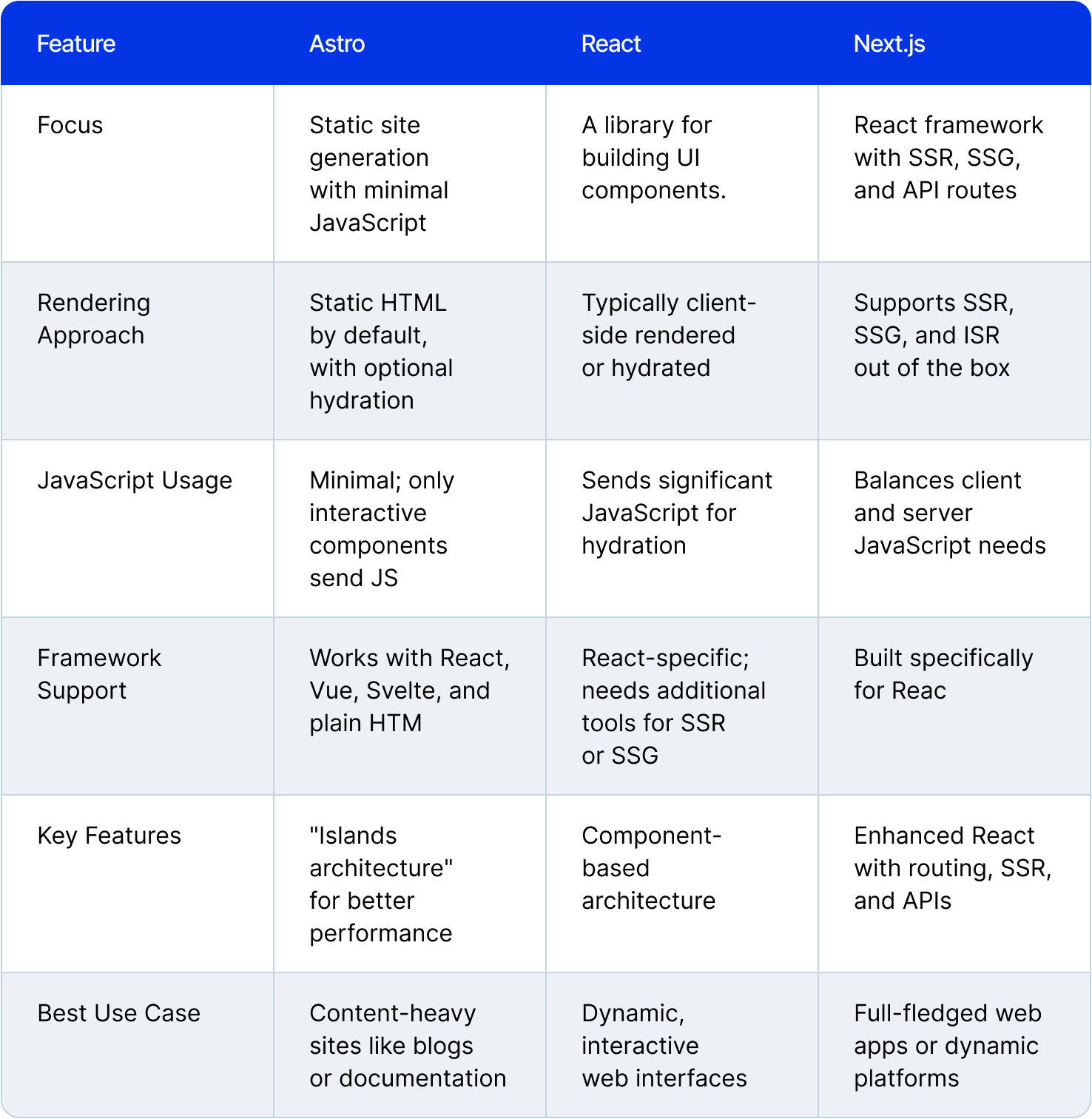
Does Astro’s future look bright?
We believe so, as 29.2% of developers say they would like to learn it in the future. Given that it’s a young framework, this level of interest is really impressive. Brian Rinaldi, Developer Relations Lead at LocalStack, told us that he fully expects Astro to continue to grow rapidly.
SvelteKit – smaller bundle sizes and faster initial load times

SvelteKit is another emerging contender, with 17.4% of surveyed programmers saying they used it in 2024. It’s an advanced web development framework built on the concepts of Svelte and Vite. It was designed with speed and ease of use in mind. It removes the hassle of configuring bundlers, setting up routing, managing server-side rendering (SSR), handling TypeScript, and adjusting deployment settings.
What’s so great about SvelteKit?
- Fast and lightweight. This modern web development framework offers a better user experience as it optimizes code to take up less space and, therefore, load faster. This is especially beneficial for apps that need a lot of silent-side rendering and scripting.
- Flexible. It lets developers structure and build web apps to match their specific project needs. They can tweak different aspects of the framework, such as routing, rendering techniques, and integrations. It integrates nicely with modern web development tools like TypeScript and GraphQL, which developers definitely appreciate.
- Easy to learn. It’s a good choice for those who are just starting out in web development. On top of offering an intuitive API, it also provides easy-to-understand documentation. Unlike some other frameworks, SvelteKit needs very little setup, letting developers dive straight into building applications.
SvelteKit is versatile, so you can use it in a wide range of applications. One off the most common use cases is for web applications with advanced routing capabilities. SvelteKit’s routing system can manage unknown route segments, display custom 404 pages, and handle optional route parameters with ease.
It’s a good choice if you want to optimize a website for SEO through server-side rendering. Adding a sitemap to a SvelteKit website, especially as the content grows, can boost SEO performance significantly.
Does SvelteKit stand a chance to dethrone Next.js. or is it a temporary web dev 2024 trend? While we don’t think frameworks like Astro or SvelteKit will pose a threat or replace Next.js, we think their popularity will grow as they bring a bit of freshness to the way web apps are built. If we look at the 2022 SOFE results, we can see that the usage of Svelte has grown five-fold, along with other frameworks like Astro. So, we don’t think it’s a temporary trend but rather a shift in preference.
Qwik – better initial page load and time to interactive

While Qwik is used (and liked) by just 4.1% of the developers we surveyed, it’s been getting a lot of attention in the frontend community. Almost one in four respondents (24.3%) said they wanted to learn it in the future.
What makes it so interesting for developers? The team behind Qwik claims it “solves a problem that other frameworks can’t solve,” meaning it offers instant-on startup performance. Regardless of the number of components within an app, the framework delivers the same initial amount of JavaScript.
It’s also built around edge-ready architecture. Qwik is optimized for server-side rendering and edge deployments, which can improve app scalability and responsiveness.
Another reason Qwik is among the top frameworks to watch is its gentle learning curve. While it’s created around new fundamentals like fine-grained reactivity and instant reusability, it’s also designed with JSX-based frameworks, including React, in mind. Routing processes have been inspired by Next.js, while the process of developing components works nearly the same way as in React. This makes for a developer-friendly experience, as it’s relatively easy to integrate Qwik into existing workflows.
These features make Qwik a good choice for resource-intensive and highly interactive applications. In a few years, it will be interesting to see if Qwik can take a chunk of the frontend market from more established web development frameworks.
SolidJS – for greater performance

SolidJS is a JavaScript framework that is already gaining popularity as a solution that offers a fast developer experience. Though we did not run a numerical study of its popularity in the latest SOFE report, several developers whom we spoke to mentioned it as a promising new framework, alongside Qwik.
SolidJS uses reactive primitives, which make the framework highly efficient and ensure that updates happen only when and where needed. This, in turn, improves app performance on both the client and server side.
As with many other ‘newer’ frameworks, SolidJS “stands on the shoulders of giants” – which would be React and Knockout in this case. This means that developers who have experience with React functional components and hooks will feel familiar with Solid right from the beginning. The creators outright declare that Solid is built with the same philosophy as React, reflecting read/write segregation and unidirectional data flow.
Some of the reasons why SolidJS made it to our watchlist include the following factors:
- Its performance is likely to get even better. Solid’s fine-grained reactivity can make it outperform established solutions and appeal to developers who prioritize speed.
- Active community. As of late 2024, there were nearly 60,000 users and over 170 contributors to SolidJS on GitHub, which indicates increasing adoption.
- It fits the latest framework development trends. With a shift toward lightweight, optimized tools, like the previously mentioned Svelte and Qwik, Solid can also attract more developers’ attention.
How developer preferences have shifted over the last 4 years
During this time, React maintained its top framework position, while newer frameworks like SvelteKit and Astro have gained more traction.
In 2020, over 74.2% of developers we surveyed used React, followed by Angular and Vue.js, which unsurprisingly ranked among the top three most popular JavaScript frameworks. We have already noticed signs of disruption from next-generation frameworks like Svelte and Stencil, which programmers have found appealing because of their leaner builds and stronger TypeScript support. The adoption of Vue and Angular stalled, mainly due to a delay in major updates.
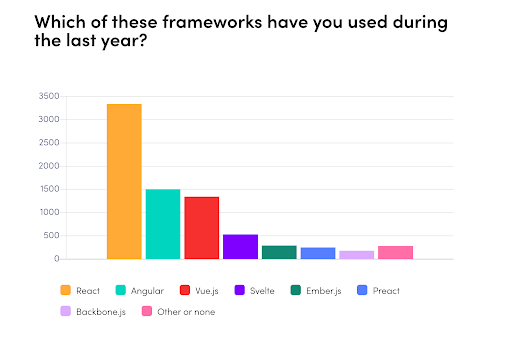
In 2022, the adoption of meta frameworks like Next.js (43.1%), Nuxt (9.4%), and Svelte (16.9%) began to pick up – and for good reason, since developers started to put performance and accessibility first. Edge rendering, mastered by platforms like SvelteKit and Remix, became a promising trend. Nearly 50% of programmers we surveyed mentioned Svelte as the framework they most wanted to learn in the future. Svelte popularity was likely driven by its ease of use and alignment with current best practices in software development.
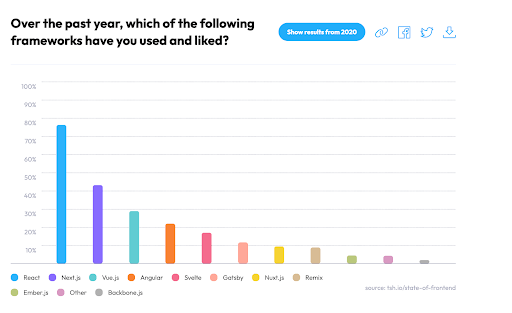
In 2024, React (69.9%) and Next.js (52.9%) still held dominant positions but new web frameworks like SvelteKit and Astro rose in popularity. Astro, with its flexibility and “islands” approach, reached a remarkable 25% adoption rate despite being new.
SvelteKit’s appeal stemmed from its simplicity and reactivity, with 43.6% of developers expressing interest in learning it in the future. Modern web development tools HTMX and Qwik also didn’t go unnoticed; their adoption grew thanks to their innovative approaches to web development.
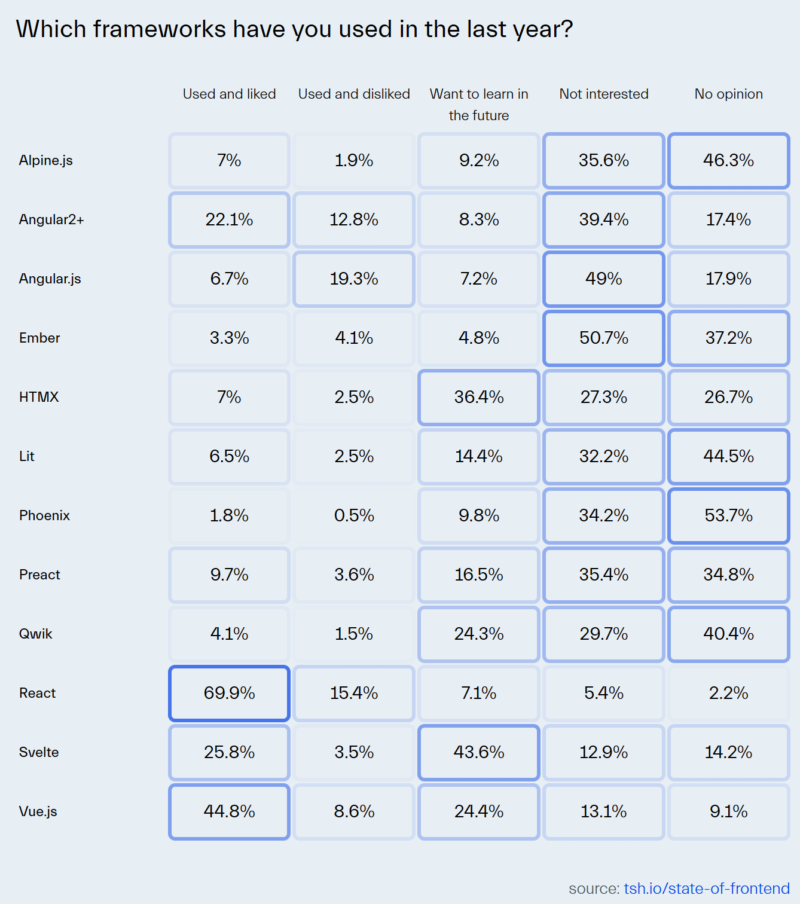
Timeline of frontend changes
Future frontend trends and framework changes
Learn more about web dev trends that will dominate in 2025 and beyond, take a look at our State of Frontend 2024 report.
We believe that three web development trends will emerge in 2025 and beyond.
- Server-side rendering and static site generation will remain popular, with Next.js leading the way in enhancing SSR performance. This trend reflects the growing need for faster and SEO-friendly applications. At the same time, SSG is also gaining traction thanks to frameworks like Astro and Next.js, which allow programmers to efficiently generate static content and build high-performance websites.
- We also think edge computing will play an important role in frontend development. IDC noted a 14% increase in edge computing use worldwide in 2024, and the interest is expected to continue. A late-2024 feature piece in CIO Magazine also notes this trend, attributing much of the growing interest in incorporating edge-computing-based AI tools into developer practices.
- Artificial intelligence is also more than likely to influence framework design and developer work. As we’ve reported in the 2024 State of Frontend report, 75.8% of frontend developers admitted to using AI in their work, primarily for code assistance (89.3% of respondents). It’s also becoming more present in processes like code testing and app performance optimization. That said, we’re yet to see if AI will be fully integrated into frameworks themselves.
Looking to choose the most fitting framework for your next project?
Our team of experienced developers is here to guide you. Whether you’re considering React or exploring the potential of Astro or Svelte, our tech consultants help you pick the framework that best suits your business goals and budget.
Reach out today, and let’s build something extraordinary together!

